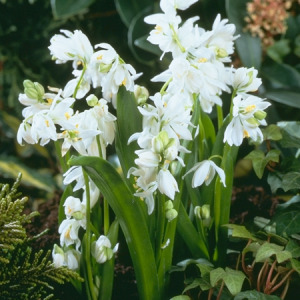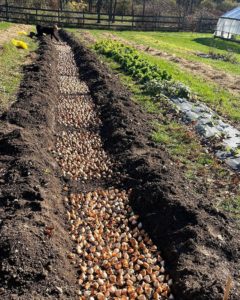Hello fellow readers, It’s an ideal time to plant spring flowering bulbs, so don’t put away the gardening gear just yet. I adore sharing a deer-resistant lineup to extend the bloom, suggested by my friend and design colleague, Marty of Three Seasons, who touts, “You can get three to four months of continuous bloom from bulbs with the right planning.” Brent and Becky Bulbs, one of our favorites, has a nifty blub finder in their online catalog that allows you to search by bloom time and genus to make planning a breeze.
Bulbs to Extend Spring Blooms

Siberian Squill / siberica‘Alba’
You know winter is over when Glory-of-the-Snow (Chionodoxa) blooms its cheery star-like flowers in pink, white, or purple. Then there’s Siberian Squill, Scilla siberica ‘Alba’, essential to the early-spring garden, with pure white bells hanging in loose clusters on strappy leaves. They also come in blues, pinks, and violets.
Choose a mix of daffodils, from small ones such as ‘Tete-a-Tete’ to taller ones such as ‘Thalia,’ which are fragrant, all white, with multiple blooms on one stem. The all-yellow Narcissus ‘February Gold’ is one of the earliest daffodils to bloom, about the same time as the not-so-common Iris reticulata – a tiny, fragrant iris in glorious blues, white and yellow. Add the later white blooming Poet’s Daffodil ‘Pheasant’s Eye’ with little orange centers (N. poeticus var. recurvus).
Ornamental Onions (Alliums) offer a sweet-smelling June flower. Varieties such as Allium ‘Globemaster’ with large pom pom-like flowers paired with Foxtail Lily’s long spikes (Eremurus) add drama to the early-summer garden. What a performance!

Allium with Eremurus
When and How to Plant Bulbs
A good rule of thumb is to plant bulbs when the average nighttime temperature is between 40 and 50 degrees or about six weeks before the ground-freezing frost —mid-to-late fall in our neck of the woods. You don’t want to plant bulbs too early as it can lead to fungus or disease problems. Rather than a contrived row, plant them randomly and close together, preferably fifty or a hundred, to make a real impact.
Generally, bulbs should be planted at a depth about three times the bulb’s height but follow package directions. They must have sufficient drainage, so loosen the planting area beyond where you plant the bulbs if the ground is compacted.
Gadget lovers rave about bulb augers that you attach to a heavy-duty drill. They are about 2 inches wide and 2 feet long and work just like a drill bit. But digging the old-fashioned way may be more manageable for tough clay and rocky soil like ours.
A Quick way to Plant Bulbs

Glory-in-Snow/ Chionodoxa luciliae

The trenching technique in action at Little Big Farm!
I’ve learned a quick way to plant is to dig a trench as deep as your bulb directions specify – placing the soil on old plywood or stiff cardboard as you dig. Loosen the dirt at the bottom of the trench and position bulbs planting the pointy end up. Slide the soil back in and water thoroughly if the soil is dry. If you can’t figure out which is the pointy end, plant the bulbs on their side. They’re geotropic, which means they’ll right themselves as they grow. In other words, bulbs know which end is up—smart bulbs (smile).
Suppose I add snowdrops to Marty’s lineup, though she’s not a snow lover like me. Galanthus create beautiful carpets of adorable little nodding white bells that sit above grass-like foliage just about when winter is coming to an end resembling blankets of snow. Not only can you extend the bloom, but you can extend the snow.
Garden Dilemmas? AskMaryStone@gmail.com and your favorite Podcast App.

Photo by Yiran Yang on Unsplash
There’s more to the story, including Phil’s Squirrel Dilemma, sure to bring a laugh, in Episode 81 of the Garden Dilemma’s Podcast:
Link to a story about No-Till Gardening with Patti Doell of Little Big Farm.
Link to Brent & Becky’s Bulb Website



Hi Mary,
About those pretty onions, I hope you meant sweet smelling and not sweat smelling:)
I enjoyed your article. I’m going to look for those Glory in the Snow bulbs. I love the color.
Thanks for catching the typo Rosemary, Corrected now. Sweet it is :^)